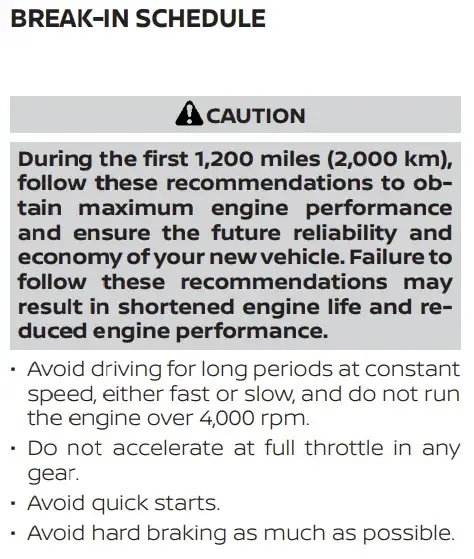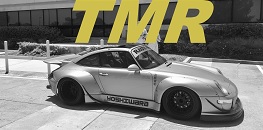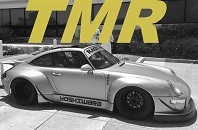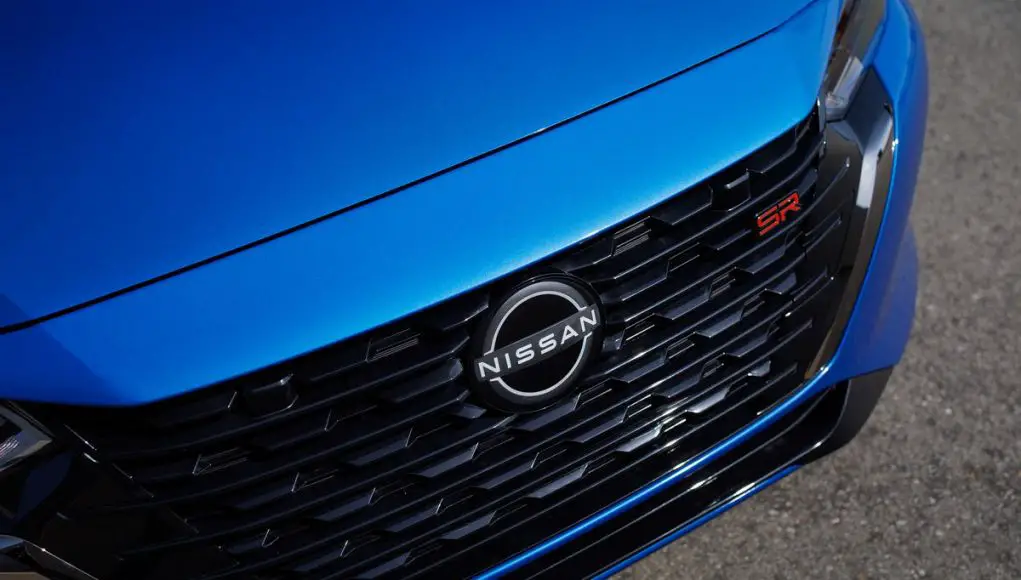Varying your speed and RPMs in the first 1,200 miles is essential during the break-in period if you want your Nissan’s engine to last for the long haul.
Crack open the owner’s manual on your new Nissan (Sentra, Altima, Rogue, Titan, etc.) and you’ll come across the prescribed break-in schedule.
As shown, the Break-In Schedule gives you four driving patterns you must do over the next 1,200 miles, “to obtain maximum engine performance and ensure the future reliability and economy of your vehicle.”
Here’s what it says in the Nissan Sentra manual.

The second, third, and fourth recommendations to not accelerate at full throttle, avoid quick starts, and avoid hard braking make logical sense as although new engines today are almost ready to roll out of the factory, it’s still a new-new engine; all those parts need time to break in.
But, why is Nissan asking me to “avoid driving for long periods at constant speed, either fast or slow, and do not run the engine over 4,000 RPM?“
What is the purpose of that?
Isn’t a steady, constant engine operation less stressful on an engine?
For new engines, not exactly.
On every new engine, there’s a cross-hatch pattern scratched in a criss-cross pattern on every cylinder wall with a tool, robotic or not, called a hone.
Here’s what one cross-hatch pattern on this guy’s engine looks like.
Cylinder crosshatching is this alright?
byu/ll-Divinity-ll inEngineBuilding
When a brand-new engine is started for the first time, the rings on the piston aren’t a perfect match to the cylinder walls yet. They’re close, but not sealed tightly.
So the cross-hatch + the piston rings rub against each other while the engine runs. This rubbing slowly wears both parts into a perfect fit.
This is what people mean by the “break-in” or “seating” process.
If you keep the engine at one RPM and load (like cruising at 65 mph on the freeway for an hour), then:
- The piston rings only contact the same part of the cylinder walls over and over.
- That part gets worn a lot more, and other areas get ignored.
- You end up with uneven wear, and maybe even a tiny ridge inside the cylinder where nothing ever touched.
Not right away, but in the long run, you’ve created a less-than-perfect cylinder seal, which will ultimately lead to combustion gases and oil leaking by, causing inefficient combustion, less power, and excessive oil consumption.
By varying your speed
- You’re making the pistons move differently every time.
- This presses the rings into different areas of the cylinder wall.
- The contact between the rings and walls becomes even all the way around.
This creates the best possible seal, which means your engine will be as efficient and powerful as it was engineered to be for the lifetime of your vehicle.
How should I drive, then?
The best way to avoid a constant speed and RPM for the first 1,200 miles is to not use your cruise control; that’s practically a death sentence for your engine’s longevity.
Accelerate using your gas pedal only.
If you can, try to avoid highway driving, as that leads to setting and forgetting your speed for long periods of time.
City driving is best as you’re forced to go up and down the RPM range.
If you must drive on the highway, get up to speed and simply yo-yo withing a couple miles an hour of your target speed for any interval you’re comfortable with.
For example.
5 mins going 65 MPH
5 mins going 70 MPH
5 mins going 75 MPH
5 mins going 70 MPH
5 mins going 65 MPH
…and etc.
You can also do 10 or 15-minute intervals.
The point is to vary your speed and RPM for the duration of your drive.
Before you know it, you’ll have crossed 1,200 miles and can now drive as you see fit, within reason, of course.



